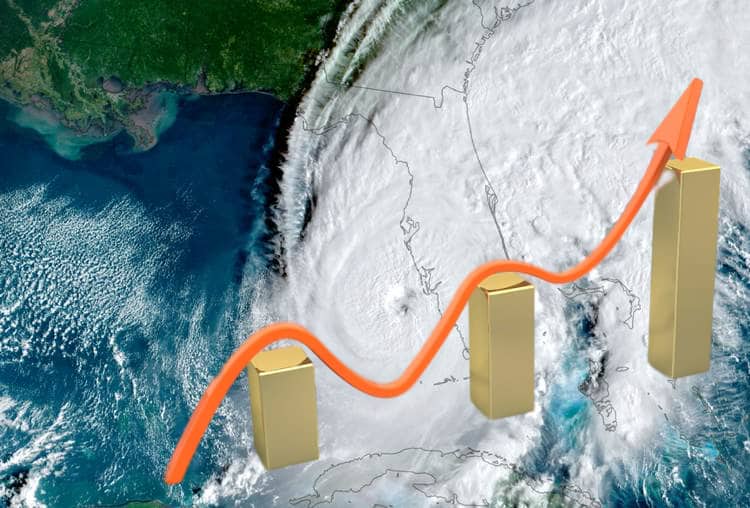Cat bond spreads widen in secondary market, RMS V23 said having an effect

Over the course of the last month, what had been an environment of catastrophe bond spreads tightening has shifted to one where spread widening has been seen through most of April and into the first week of May, which alongside more balanced supply and demand, some attribute at least in part to the latest hurricane risk model update from Moody’s RMS.
Cat bond investment manager Plenum Investments has said that, with the update to the Atlantic hurricane model due in June, the market is shifting its view on risk already, resulting in additional spread widening being seen.
Risk model updates have driven fluctuations in the catastrophe bond market in the past, as new and updated views of risk adjust the common metrics that ILS investors and cat bond fund managers utilise.
As risk metrics adjust and the view of risk changes, it can affect investor appetite and also the perception of the cost-of-capital, as well as return on capital required, in the catastrophe bond and broader insurance-linked securities (ILS) marketplace.
The impending update to the Moody’s RMS hurricane model to version 23 has already triggered a response in the cat bond market, we are told, with some such as Plenum Investments reporting that at least a portion of the recent spread widening has been driven by it, particularly in the last week.
Model updates such as this change the expected loss profile of portfolios of catastrophe bonds, meaning that analysis is required, sometimes adjustments to portfolio mix and positioning, but perhaps more importantly it can elevate the perceived cost-of-capital for the sector and drive a demand for higher prices and returns.
It’s natural with an impending change to the risk profile of funds and portfolios, for those measuring their expected losses using a Moody’s RMS model, to have an effect on risk appetite.
Plenum Investments said, “In this latest version, expected losses will on average be higher as compared to the previous version, due to several factors. These factors include continued anticipated rise in sea surface temperatures over the coming years, increased exposures due to inflation, and additional claims data leading to a better understanding of building vulnerabilities to hurricanes. Though the projected change in expected losses varies by region and business line, we can anticipate that on average the expected loss across the US and all lines of business will increase as compared to the previous version, with Florida being the driver of the change.”
With the official start of the hurricane season approaching, amid forecasts for a very busy year and some ILS managers already positioning for that possibility (as we reported back in March), it’s perhaps no surprise there would be some reaction to these updates.
Plenum continued to explain, “The recent update to the Atlantic hurricane model underscores the insurance industry’s adeptness in responding to evolving risks. Through precise risk assessment in transactions, the industry guarantees accurate pricing, safeguarding against potential financial vulnerabilities.
“Observing last week’s price reactions in the CAT Bond market, it appears that the market may account for this new view of risk, with prices of index-linked CAT Bonds decreasing more significantly than indemnity bonds. In addition to our typical underweight positioning in index-linked CAT Bonds relative to the market, we have exercised caution over recent months and tried to avoid investments in bonds most affected by the model update.”
There have been other effects through April, that have driven cat bond spreads to widen.
These have included a more balanced supply and demand dynamic, as robust issuance soaked up cash in the market that had been freshly raised or recycled through maturities.
In addition, with a number of larger issues, including the recent TWIA issuance, the yet to price Florida Citizens Everglades Re cat bond and a rumoured cat bond for State Farm that could also be quite large, there has been an element of cat bond fund managers preparing and withdrawing some liquidity from the market to be allocated to these deals.
That resulted in steady spread widening through April, reversing the trend seen through the first-quarter where spreads tightened consistently, as investors look to demand a higher compensation for holding risk again.
The spread widening seen in April was quite dramatic, with some saying it was more typical of what you might see after a loss event, in certain parts of the cat bond market at least.
It also translated to the primary cat bond market, with a few deals seen pricing higher than had been anticipated originally.
Some investors we’ve spoken with this week said the shift, from ever-tighter spreads through Q1 into April’s spread widening, is one of the most dramatic shifts they’ve ever seen without a specific loss event as a driver.
The moves seen last week, being especially reflected in industry-index cat bonds and bonds exposed to regions such as Florida, are thought to be linked in part to the increased modelled losses that the Moody’s RMS V23 model suggests.
Moody’s RMS’s version 23 model update is expected to be one influencing factor for reinsurance underwriting firms and ILS capital providers at the mid-year reinsurance renewals.
Adjustments can result in higher modelled catastrophe losses in certain regions and states of the US, which will affect risk appetites.
So, it’s natural that such changes would affect the catastrophe bond and broader insurance-linked securities (ILS) marketplace, at least to a degree.
As the industry improves its view of risk and the technology it uses to analyse risk gets updated to incorporate the latest science and thinking, there will always be an effect on the risk appetite of capital providers, their return requirements and their approach to portfolio risk management.






